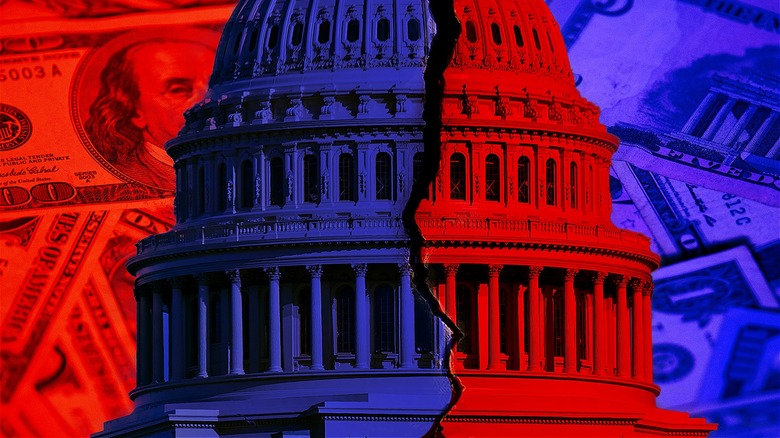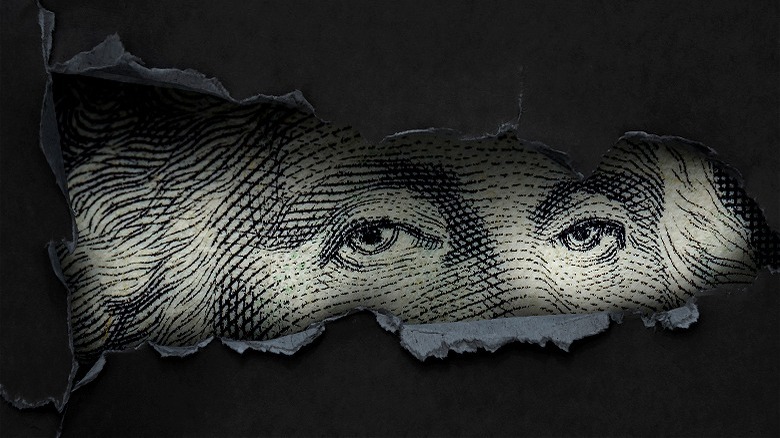This Is The Most Money Ever Spent On A Presidential Campaign
Elections have increasingly become an expensive process. While running for office in the United States has never been cheap, record-breaking spending has distinguished more recent elections (at both the state and federal levels) as some of the most expensive campaigns in U.S. history. Further, along with higher spending, traditional funding sources have also been changing — fundamentally shifting the way political campaigns focus their fundraising efforts. As more voters get involved in the political process through small individual donations, you can expect high campaign spending totals to continue, especially for presidential candidates.
The 2016 election broke previous campaign spending totals at almost $6.5 billion, a 3% increase over 2012 election spending. However, this amount was quickly eclipsed by the 2020 election, and by a lot. According to campaign finance watchdog OpenSecrets, spending in 2020 totaled $14.4 billion, with the presidential election between Joe Biden and Donald Trump accounting for nearly 40% of the total, at $5.7 billion. By comparison, in 2016, the White House race between Hillary Clinton and Donald Trump cost $2.4 billion.
The 2020 presidential election also saw Biden become the first candidate in history to raise more than $1 billion from donors alone. The other $8.7 billion of the $14.4 billion in election spending in 2020 went to several hotly contested congressional races. In fact, nine of the 10 most expensive Senate races in U.S. history happened during the 2020 election.
Where campaign money comes from
During the last decade, there have been notable shifts in how campaign dollars are raised during a presidential campaign. Two groups, in particular, have changed the election finance landscape. The first is small individual donors, who generally give less than $200 to a candidate's campaign. Small donors accounted for 15.2% of total funds in the 2016 election, whereas they accounted for 22.9% in 2020. The next is wealthy individual donors, who accounted for 48.6% of all funds during the 2016 election. However, as small individual donors have gained traction, wealthy donors have seen their influence wane. During the 2020 election, wealthy individual donors accounted for just 42.6% of total funding.
If you're wondering why individual donors have crept up in political donations of late over more traditional models like political action committees (PACs), the answer comes down to funding limits. Unlike individual contribution limits, which increase every election in order to account for inflation, PAC contribution limits have remained unchanged since 2003. Currently, according to the Federal Election Commission, a PAC can only give up to $5,000 to a single candidate per election.
This is also part of why corporations pushed for deregulation in election fundraising and in 2010, thanks to a Supreme Court decision, they got their wish with the introduction of super PACs. Super PACs can receive unlimited contributions from individuals, corporations, labor unions, and even from other PACs, making them a more appealing option for business interests looking to influence politics. SuperPACs spent almost $3.3 billion on the 2020 election, which was nearly double their 2016 spending.
Dark money and elections
Perhaps the biggest hot-button topic in political fundraising in the U.S. today is dark money. The term is used to describe money coming from undisclosed people/groups that's ultimately meant to influence political decisions. This happens through either 501(c)(4) nonprofits that aren't legally obligated to disclose donors or through shell companies. Since super PACs must disclose who their donors are, channeling money through a less-than-transparent nonprofit or shell company allows groups, corporations, and individuals to fund campaigns, parties, or actions privately. This means there's no way to trace donations back to the donor, which can make it difficult for the American people to know exactly who is funding candidates or legislation.
Dark money is also connected to the 2010 Supreme Court decision that allowed for Super PACs in the first place: Citizens United v. Federal Election Commission. Due to both the weak enforcement of super PAC coordination rules, and loopholes in disclosure requirements, outside groups have been able to take advantage of these changes in campaign fundraising. OpenSecrets reports the top seven super PACs in the 2020 election (in terms of spending) were all partially funded by dark money, and at the federal level, over $1 billion in dark money was spent. While this money has primarily been spent on physical mailers or TV or online ads in the past, internet discourse has changed dark money possibilities. According to research from the University of Texas at Austin, many super PACs paid online influencers, including lesser-known "regular" people, to spread specific political viewpoints and propaganda during the 2020 election.


